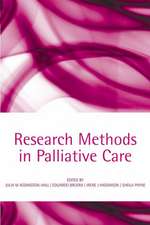Osteoporosis Research: Animal Models
Editat de Gustavo Duque, Ken Watanabeen Limba Engleză Paperback – 20 aug 2014
Research in the field of osteoporosis has grown in recent years. This has resulted in significant advances in determining the causes of osteoporosis, assessing risk factors, and creating new treatment methods. The use of animal models provides important knowledge about pathological conditions that can eventually lead to the development of more effective clinical treatment of diseases in both humans and animals.
Osteoporosis Research - Animal Models, is an essential tool for researchers in the bone field. This book aids researchers in selecting their appropriate model and highlights the experiments that can be strategically designed to optimize the potential of an animal to develop the cardinal features of osteoporosis in humans. This book addresses the importance of recent findings from animal models and their significance on the pathogenesis of osteoporosis in relation to human disease.
| Toate formatele și edițiile | Preț | Express |
|---|---|---|
| Paperback (1) | 895.86 lei 38-44 zile | |
| SPRINGER LONDON – 20 aug 2014 | 895.86 lei 38-44 zile | |
| Hardback (1) | 665.34 lei 38-44 zile | |
| SPRINGER LONDON – 25 mai 2011 | 665.34 lei 38-44 zile |
Preț: 895.86 lei
Preț vechi: 943.01 lei
-5% Nou
Puncte Express: 1344
Preț estimativ în valută:
171.43€ • 179.58$ • 142.07£
171.43€ • 179.58$ • 142.07£
Carte tipărită la comandă
Livrare economică 04-10 aprilie
Preluare comenzi: 021 569.72.76
Specificații
ISBN-13: 9781447162292
ISBN-10: 1447162293
Pagini: 216
Ilustrații: XIX, 196 p.
Dimensiuni: 193 x 260 x 11 mm
Ediția:2011
Editura: SPRINGER LONDON
Colecția Springer
Locul publicării:London, United Kingdom
ISBN-10: 1447162293
Pagini: 216
Ilustrații: XIX, 196 p.
Dimensiuni: 193 x 260 x 11 mm
Ediția:2011
Editura: SPRINGER LONDON
Colecția Springer
Locul publicării:London, United Kingdom
Public țintă
ResearchCuprins
How to select your animal model for osteoporosis research.- Skeletal phenotyping in rodents: tissue isolation and manipulation.- Methods in bone biology in animals – Biomechanics.- Methods in Bone Histomorphometry for Animal Models.- Methods in bone biology in animals.- Methods in bone biology in animals - Biochemical markers.- Methods in Bone Biology: Cancer and Bone.- How to test osteoporosis treatments in experimental animals.- The ovariectomized mice and rats.- Classical Models of Senile Osteoporosis.- Animal Models of Premature Aging.- Non-human primate models of osteoporosis.- Other large animal models.- Models for the study of fracture healing and bone regeneration
Textul de pe ultima copertă
Osteoporosis Research - Animal Models, presents in a very illustrative and practical manner, general methodologies of bone studies in animals, as well as the particular features of the most commonly used animal models in the field.
Research in the field of osteoporosis has grown in recent years. This has resulted in significant advances in determining the causes of osteoporosis, assessing risk factors, and creating new treatment methods. The use of animal models provides important knowledge about pathological conditions that can eventually lead to the development of more effective clinical treatment of diseases in both humans and animals.
Osteoporosis Research - Animal Models, is an essential tool for researchers in the bone field. This book aids researchers in selecting their appropriate model and highlights the experiments that can be strategically designed to optimize the potential of an animal to develop the cardinal features of osteoporosis in humans. This book addresses the importance of recent findings from animal models and their significance on the pathogenesis of osteoporosis in relation to human disease.
Research in the field of osteoporosis has grown in recent years. This has resulted in significant advances in determining the causes of osteoporosis, assessing risk factors, and creating new treatment methods. The use of animal models provides important knowledge about pathological conditions that can eventually lead to the development of more effective clinical treatment of diseases in both humans and animals.
Osteoporosis Research - Animal Models, is an essential tool for researchers in the bone field. This book aids researchers in selecting their appropriate model and highlights the experiments that can be strategically designed to optimize the potential of an animal to develop the cardinal features of osteoporosis in humans. This book addresses the importance of recent findings from animal models and their significance on the pathogenesis of osteoporosis in relation to human disease.
Caracteristici
It will describe the most common methods used in animal models of bone research. This book will provide some detailed protocols for sample acquisition and manipulation, data obtention and data interpretation. Techniques such as bone histomorphometry, microCT and ex vivo cultures will be described in detail. A clear distinction between animal models for postmenopausal and senile osteoporosis is made in this book. This distinction will provide the reader with a better and more appropriate selection when testing treatments in animal models of menopausal vs. senile osteoporosis. This book will be especially useful to bone biologists and gerontologists. Differences between methodologies when looking at hormonal effect versus the aging process will be highlighted and will provide the reader with a better understanding of the model and their expected results. Includes supplementary material: sn.pub/extras













